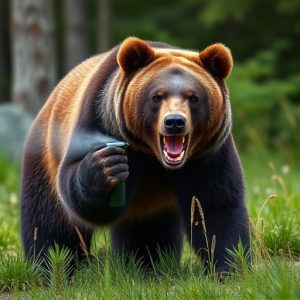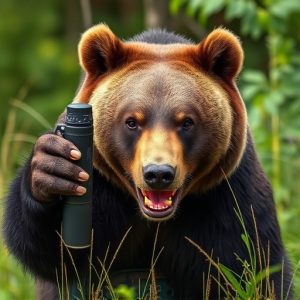Bear Attack Prevention: Unlocking the Power of Spray Equipment
Understanding bear behavior is crucial for preventing attacks, especially in areas where bears roam……..
Understanding bear behavior is crucial for preventing attacks, especially in areas where bears roam. Bear spray, designed specifically for bear-human interactions, is more effective than regular pepper spray due to its unique combination of capsaicin and other components that penetrate fur and irritate a bear's sensitive nose and eyes, causing disorientation and escape. Studies confirm bear spray's superior efficacy against both black and grizzly bears compared to standard pepper spray, making it a crucial tool for outdoor enthusiasts in bear-inhabited areas. When used correctly, bear spray can be a game-changer in navigating regions with these formidable animals, especially considering its power and effectiveness against large predators like grizzlies.
“In regions where bears roam, understanding and preparing for potential encounters is vital. This article explores an essential tool in bear attack prevention: bear spray equipment. We delve into the fascinating world of bear behavior, uncovering their sensitivities and triggers. The science behind bear spray is demystified, focusing on active ingredients and its proven effectiveness. Additionally, a comparative analysis between bear spray and pepper spray reveals which option offers superior protection, addressing the question: Is bear spray stronger than pepper spray?”
- Understanding Bear Behavior and Their Sensitivities
- The Science Behind Bear Spray: Active Ingredients and Effectiveness
- Pepper Spray vs Bear Spray: A Comparative Analysis
Understanding Bear Behavior and Their Sensitivities
Understanding bear behavior is crucial when it comes to preventing and mitigating attacks, especially in areas where bears are known to roam. These powerful animals have complex sensory systems that can detect even slight changes in their environment. They are particularly sensitive to scents, which play a significant role in their communication and survival. Bear spray, a popular defense mechanism, has gained attention for its potential effectiveness against these creatures.
When considering the question of bear spray strength compared to pepper spray, it’s important to note that bear spray is specifically designed to deter bears through a unique combination of capsaicin (the active ingredient in chili peppers) and other components. While pepper spray is known for its intense irritation to human eyes and respiratory system, bear spray is formulated to penetrate the thick fur and reach the bear’s sensitive nose and eyes directly, causing disorientation and escape. This specialized nature makes bear spray a more effective tool in specific bear-human interactions, ensuring hikers and campers have a reliable means of protection when facing these formidable animals.
The Science Behind Bear Spray: Active Ingredients and Effectiveness
Bear spray, also known as bear deterrent spray, is a specialized pepper spray designed to protect individuals from aggressive bears. The science behind its effectiveness lies in its active ingredients and how they interact with the bear’s sensory system. Typically, bear spray contains capsaicin, the same compound found in chili peppers that gives them their heat. However, unlike regular pepper spray, which primarily affects the eyes and respiratory system, bear spray is formulated to target the bear’s olfactory (smell) receptors.
The key active ingredient in most bear sprays is oleoresin capsicum (OC), a potent form of capsaicin mixed with other natural oils. OC irritates the bear’s nose, eyes, and throat, causing it to recoil and retreat. Studies have shown that when used correctly, bear spray can be highly effective, providing protection against both black bears and grizzly bears. In fact, compared to regular pepper spray, bear spray is generally considered stronger due to its specific formulation to combat larger, more powerful animals like bears.
Pepper Spray vs Bear Spray: A Comparative Analysis
When it comes to bearing the brunt of a bear attack, choosing the right defense mechanism is paramount. This often leads to an age-old debate: Pepper spray vs Bear spray. While both serve as deterrents, they are designed for different purposes and environments.
Pepper spray, known for its burning sensation, is effective against humans and smaller animals due to its quick onset of effect. It’s a popular choice for personal protection in urban areas and during outdoor activities where the risk of encountering aggressive dogs or humans is higher. However, when faced with a grizzly bear, pepper spray might not be as potent. Bear spray, specifically formulated to deter bears, contains capsaicin mixed with other ingredients like garlic and putrescent egg odor. This combination creates a powerful scent that can trigger a bear’s natural aversion response, even at long distances. Thus, in terms of sheer power, bear spray often emerges as the more effective choice against larger predators like bears, making it an indispensable tool for hikers, campers, and those navigating bear country.
Bear attack prevention sprays, particularly those containing capsaicin (the active ingredient in pepper spray), offer a crucial tool for outdoor enthusiasts navigating bear country. While debates persist about which type—bear spray or pepper spray—is more effective, both serve as powerful deterrents when used correctly. Understanding bear behavior and choosing the right equipment can significantly enhance safety during encounters. In terms of comparing is bear spray stronger than pepper spray, research suggests that bear spray is generally more potent due to its specialized formulation to address bears’ sensitive eyes and respiratory systems. Ultimately, proper education and preparation are key to ensuring safe interactions with these majestic animals in their natural habitats.


